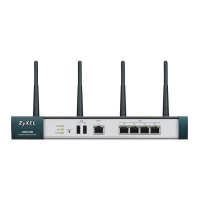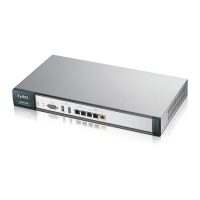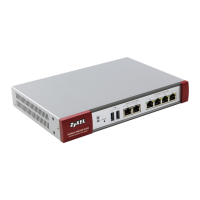Chapter 24 Web Authentication
UAG CLI Reference Guide
143
24.2.1 web-auth login setting Sub-commands
The following table describes the sub-commands for the web-auth login setting command.
web-auth policy append Creates a new condition for forcing user authentication at the end of the
current list and enters sub-command mode. See Table 81 on page 145 for
the sub-commands.
web-auth policy insert <1..1024> Creates a new condition for forcing user authentication at the specified
location, renumbers the other conditions accordingly, and enters sub-
command mode. See Table 81 on page 145 for the sub-commands.
web-auth policy delete <1..1024> Deletes the specified condition.
To modify a condition, you can insert a new condition (N) and then delete
the one (N+1) that you want to modify.
web-auth policy flush Deletes every condition.
web-auth policy move <1..1024> to
<1..1024>
Moves the specified condition to the specified location and renumbers the
other conditions accordingly.
web-auth user-agreement Enters sub-command mode to configure user agreement pages and related
settings. See Table 82 on page 146 for the sub-commands.
show web-auth activation Displays whether forcing user authentication is enabled or not.
show web-auth default-rule Displays settings of the default web authentication policy.
show web-auth exceptional-service Displays services that users can access without user authentication.
show web-auth method Displays whether a client is to authenticate with the UAG through the
specifically designated web portal or user agreement page when web
authentication is enabled.
show web-auth policy {<1..1024> | all} Displays details about the policies for forcing user authentication.
show web-auth portal status Displays the web portal page settings.
show web-auth status Displays the web portal page or user agreement page settings.
show web-auth user-agreement status Displays the user agreement page settings.
Table 79 web-auth Commands (continued)
COMMAND DESCRIPTION
Table 80 web-auth login setting Sub-commands
COMMAND DESCRIPTION
exit Leaves the sub-command mode.
type {external | internal} Sets the login page appears whenever the web portal intercepts network traffic,
preventing unauthorized users from gaining access to the network.
internal: Use the default login page built into the UAG.
external: Use a custom login page from an external web portal instead of the
default one built into the UAG. You can configure the look and feel of the web
portal page.
Note: If you select the external option, you cannot use endpoint security to make
sure that users’ computers meet specific security requirements before they
can access the network.
[no] error-url url Sets the error page’s URL; for example, http://IIS server IP Address/error.html.
You can use up to 255 characters (0-9a-zA-Z;/?:@&=+$\.-_!~*'()%) in quotes.
The
no command removes the URL.
The Internet Information Server (IIS) is the web server on which the web portal
files are installed.

